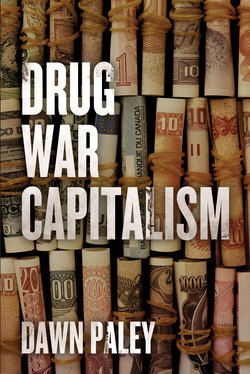Drug War Capitalism

Реклама. ООО «ЛитРес», ИНН: 7719571260.
Оглавление
Dawn Paley. Drug War Capitalism
Dedication
Foreword
Chapter 1: Drug War Capitalism
Chapter 2: Defining The Drug War
Chapter 3: A Look South To Colombia
Chapter 4: Mexico’s Drug War Reforms
Chapter 5: Plan Mexico And Militarization
Chapter 6: Mexico, Paramilitarization & The Drug War
Chapter 7: Drug War Capitalism In Guatemala
Chapter 8: Drug War Capitalism In Honduras
Conclusion: Thinking Through Peace In Wartime
Acknowledgments
Notes
Index
Drug War Capitalism
Отрывок из книги
This book is dedicated to the memory of independent photographer and journalist Ali Mustafa, 1984–2014. His bravery, fighting spirit, and commitment live on in our hearts, in our work, and in our words.
Días antes de terminar este libro recibimos las primeras noticias de los 43 normalistas de Ayotzinapa desaparecidos en Iguala, Guerrero, el 27 de septiembre de 2014. Sus nombres aquí aparecen, con la firme esperanza de que sean encontrados con vida y con la profunda rabia e indignación por lo que les haya sucedido, ¡los tenemos presentes!: Abel García Hernández, Abelardo Vázquez Peniten, Adán Abrajan de la Cruz, Alexander Mora Venancio, Antonio Santana Maestro, Benjamín Ascencio Bautista, Bernardo Flores Alcaraz, Carlos Iván Ramírez Villarreal, Carlos Lorenzo Hernández Muñoz, César Manuel González Hernández, Christian Alfonso Rodríguez Telumbre, Christian Tomas Colon Garnica, Cutberto Ortiz Ramos, Dorian González Parral, Emiliano Alen Gaspar de la Cruz, Everardo Rodríguez Bello, Felipe Arnulfo Rosas, Giovanni Galindes Guerrero, Israel Caballero Sánchez, Israel Jacinto Lugardo, Jesús Jovany Rodríguez Tlatempa, Jonas Trujillo González, Jorge Álvarez Nava, Jorge Aníbal Cruz Mendoza, Jorge Antonio Tizapa Legideño, Jorge Luis González Parral, José Ángel Campos Cantor, José Ángel Navarrete González, José Eduardo Bartolo Tlatempa, José Luis Luna Torres, Jhosivani Guerrero de la Cruz, Julio César López Patolzin, Leonel Castro Abarca, Luis Ángel Abarca Carrillo, Luis Ángel Francisco Arzola, Magdaleno Rubén Lauro Villegas, Marcial Pablo Baranda, Marco Antonio Gómez Molina, Martín Getsemany Sánchez García, Mauricio Ortega Valerio, Miguel Ángel Hernández Martínez, Miguel Ángel Mendoza Zacarías, Saúl Bruno García.
.....
The first wave of neoliberal economic policies was introduced in the form of structural adjustment programs. These programs came at the end of “the Mexican Miracle,” a period of steady economic growth, import substitution industrialization, and high oil prices. “From 1980 to 1991, Mexico received thirteen structural adjustment loans from the World Bank, more than any other country,” wrote Tom Barry in his 1995 book Zapata’s Revenge. “It also signed six agreements with the IMF, all of which brought increased pressure to liberalize trade and investment.”[22] In the 1980s, sometimes called Mexico’s “lost decade,” oil prices collapsed along with the peso. “From over a thousand state enterprises in 1983, the Mexican state owned around two hundred by 1993.... In 1991, the Mexican program brought in more money to government coffers (US$9.4 billion) than all other sales of public companies in Latin America combined.”[23] By 1988, the Mexican economy was already considered one of the most open to foreign investment in the world.[24] Many of the most important privatizations happened during the presidency of Carlos Salinas de Gortari, who was elected, in 1988, in what is widely believed to have been a fraudulent election. Mexico did go through a series of what Klein calls shocks, and some sectors (like banking and telephony) were thoroughly privatized. Still, at the outset of the drug war in Mexico, large corporations like the Comisión Federal de Electricidad (CFE) and Petroleos Mexicanos (Pemex)—the seventeenth-largest oil company in the world by oil reserves,[25] and by other counts the eighth-largest[26]—remained firmly in government hands; peasant and Indigenous communities continued to exercise communal title over lands rich in resources; a large middle class owned small businesses; and the richest Mexican families kept control over lucrative sectors of the economy. Mexican investors were favored in the privatizations that took place during Salinas’s term, coming as they did before the North America Free Trade Agreement (NAFTA) was signed.[27] According to the US State Department, Mexico’s ten richest families “are not the only obstacle[s] to improving competition in the Mexican economy.”[28] Though weakened by constitutional amendments made by Salinas before NAFTA came into effect, communal landholder organizations, including ejidos and comunidades índigenas, have not been totally undone by neoliberal reforms. By the end of 1994, Mexico had signed on to the North America Free Trade Agreement, witnessed the Zapatista uprising, and undergone another major currency devaluation, but by the turn of the twenty-first century, Mexico’s territory and economy still weren’t fully open to foreign investors. In 2000, Vicente Fox of the National Action Party (PAN) was elected president, interrupting the Institutional Revolutionary Party’s (PRI) seventy-one years of rule, and some say, returning democracy to Mexico.
But there is more than not-yet-privatized corporations that make Mexico interesting to transnational capital: take Mexico’s strategic geographical location, for example. The Mexico-US border spans nearly 2,000 miles, a line that runs from Pacific to Atlantic, from Tijuana–San Diego to Juarez–El Paso and Brownsville–Matamoros. Along some stretches, the border is fenced, in other places the unforgiving desert polices it.[29] The US border with Mexico can and should be considered a valuable economic resource; low-cost labor on the south side of the border, within spitting distance of the United States, is a winning combination as transportation costs are also reduced. As such, Mexico is becoming an increasingly significant player in US and global manufacturing. For example, in the automobile sector, located along the border as well as in the country’s interior, “Mexico is becoming the export hub for the Americas—not only North America but also South America,” according to Nissan CEO Carlos Ghosn.[30]
.....